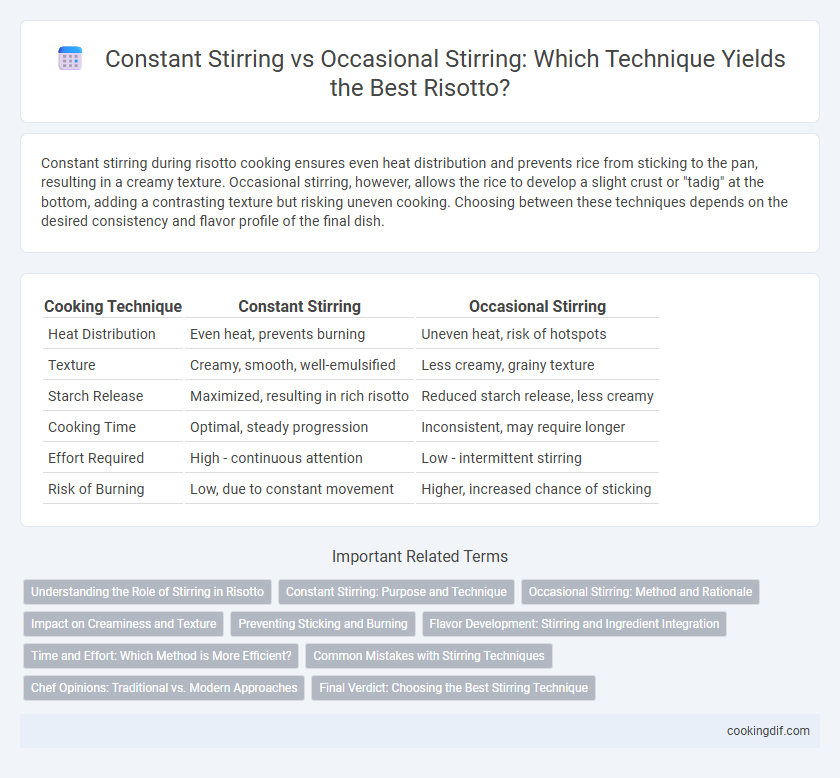Constant stirring during risotto cooking ensures even heat distribution and prevents rice from sticking to the pan, resulting in a creamy texture. Occasional stirring, however, allows the rice to develop a slight crust or "tadig" at the bottom, adding a contrasting texture but risking uneven cooking. Choosing between these techniques depends on the desired consistency and flavor profile of the final dish.
Table of Comparison
| Cooking Technique | Constant Stirring | Occasional Stirring |
|---|---|---|
| Heat Distribution | Even heat, prevents burning | Uneven heat, risk of hotspots |
| Texture | Creamy, smooth, well-emulsified | Less creamy, grainy texture |
| Starch Release | Maximized, resulting in rich risotto | Reduced starch release, less creamy |
| Cooking Time | Optimal, steady progression | Inconsistent, may require longer |
| Effort Required | High - continuous attention | Low - intermittent stirring |
| Risk of Burning | Low, due to constant movement | Higher, increased chance of sticking |
Understanding the Role of Stirring in Risotto
Stirring risotto constantly helps to release the rice's starch, creating the signature creamy texture essential to the dish. Occasional stirring may lead to uneven cooking and a less cohesive consistency, as the starch is not fully released. Optimal risotto requires frequent stirring to ensure even heat distribution and to prevent the rice from sticking to the pan.
Constant Stirring: Purpose and Technique
Constant stirring in risotto cooking enhances the rice's ability to release starch, creating a creamy, velvety texture essential for traditional risotto. This technique prevents the rice grains from sticking to the pan or unevenly cooking, ensuring consistent heat distribution and absorption of the broth. Precision in maintaining moderate heat while continuously stirring promotes optimal creaminess without overcooking or breaking the grains.
Occasional Stirring: Method and Rationale
Occasional stirring in risotto cooking allows the rice to develop a creamier texture by promoting gradual absorption of broth without overworking the starches. This technique minimizes the risk of the rice becoming gluey while enabling even cooking and enhanced flavor infusion from the liquid. Maintaining controlled, gentle stirring intervals preserves the delicate structure of the grains and achieves the desired al dente consistency.
Impact on Creaminess and Texture
Constant stirring during risotto cooking promotes even heat distribution and gradual starch release from Arborio rice, resulting in a creamier texture. Occasional stirring may cause uneven cooking and less starch gelatinization, producing a risotto with a firmer, less cohesive consistency. The traditional method favors continuous agitation to achieve the signature velvety mouthfeel characteristic of authentic Italian risotto.
Preventing Sticking and Burning
Constant stirring in risotto ensures even heat distribution, preventing the rice from sticking to the pan and reducing the risk of burning. Occasional stirring may cause uneven cooking, allowing the grains to settle and adhere to the bottom, which can lead to scorching. Maintaining consistent agitation of Arborio rice during the cooking process preserves the creamy texture and prevents overheating hotspots.
Flavor Development: Stirring and Ingredient Integration
Constant stirring in risotto cooking enhances flavor development by promoting better integration of ingredients and even release of starch from the rice, creating a creamy texture. Occasional stirring can lead to uneven cooking and less gelatinized starch, resulting in a less cohesive and less flavorful dish. Thorough agitation ensures the gradual absorption of broth, unlocking complex flavors and a smooth, rich consistency.
Time and Effort: Which Method is More Efficient?
Constant stirring in risotto cooking requires more time and effort but promotes even heat distribution and a creamier texture through continuous release of starch. Occasional stirring reduces physical effort and allows for multitasking, yet risks uneven cooking and a less cohesive consistency. Efficiency depends on prioritizing texture quality versus reduced active cooking time.
Common Mistakes with Stirring Techniques
Constant stirring during risotto preparation can cause the rice to break down and result in a mushy texture, while occasional stirring allows the grains to absorb liquid evenly and develop the desired creamy consistency. A common mistake is either neglecting to stir enough, which can cause uneven cooking and sticking to the pan, or over-stirring, which releases excess starch and affects the final texture. Maintaining a balance by gently stirring frequently but not continuously ensures the ideal al dente grains essential for authentic risotto.
Chef Opinions: Traditional vs. Modern Approaches
Chef opinions on risotto preparation diverge between constant stirring and occasional stirring techniques, reflecting traditional versus modern approaches. Traditionalists advocate for constant stirring to release the rice's starch gradually, ensuring a creamy texture, while modern chefs experiment with occasional stirring to reduce labor and test flavor development. Both methods impact the risotto's consistency and cooking time, demonstrating evolving culinary perspectives on balancing authenticity with efficiency.
Final Verdict: Choosing the Best Stirring Technique
Constant stirring during risotto cooking promotes even heat distribution and gradual starch release, resulting in a creamy and smooth texture. Occasional stirring can lead to uneven cooking and a less cohesive consistency, often producing a drier, clumpier dish. For optimal risotto, constant stirring is the preferred technique to achieve the classic creamy finish.
Constant stirring vs occasional stirring for cooking technique Infographic

 cookingdif.com
cookingdif.com